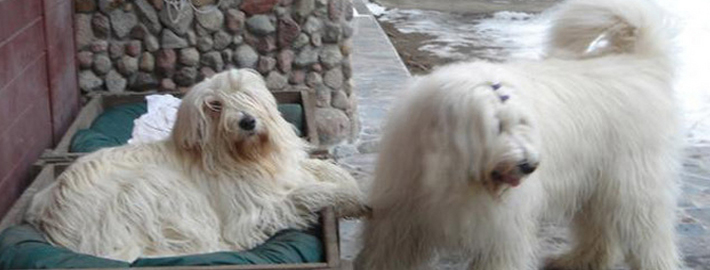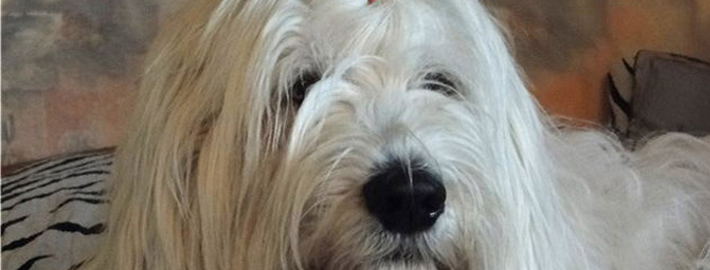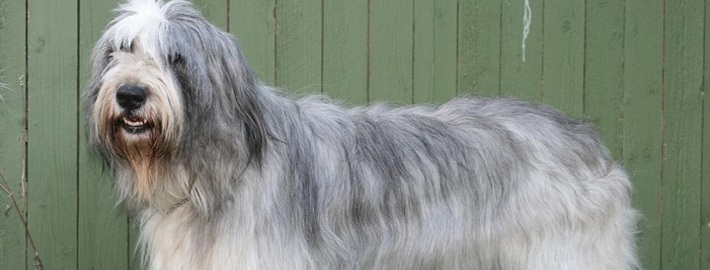What makes the South Russian Ovcharka Unique?
The South Russian Shepherd Dog is a dog of above average size and sturdily built, with a thick, dense, double coat. The race is slim, but with a massive bone structure and musculature well developed. Secondary sex characteristics are strongly marked, with males being stronger, more massive and more courageous than females. Fierce, suspicious of strangers, and dominant in character, the South Russian Shepherd Dog is able to adapt to a wide variety of weather conditions and temperatures.
Breed Groups
Page Contents
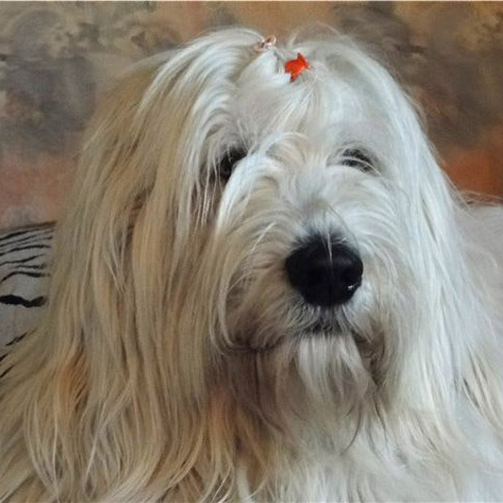
SnapShot
| Size: | Males – 65 to 66 cm (25 to 27 inches) Females – 62 to 66 cm (24 to 27 inches) |
| Weight: | Males – 48 to 50 kg (108 to 110 pounds) Females – 48 to 50 kg (108 to 110 pounds) |
| Origin: | Great Britain, Scotland, Wales, Ireland, England, United Kingdom |
| Life Span: | 9 – 11 Years |
| Colour: | Grey, White, Gray & White, White & Yellow |
| Litter Size: | up to 10 puppies |
Is the South Russian Ovcharka Right For You?
The Ovtcharka of southern Russia is a very large, robust dog. He adapts easily to diverse climatic conditions and temperatures. This breed needs an owner who knows how to display strong leadership; someone who is firm, confident, and 100% consistent. You should your authority over this flock guard, because if you don’t, he may become very dominant with strange people and other dogs. This breed is not very demanding, but he does need a strong-minded human to be his leader. Males are stronger and more massive than females. They were bred to guard their property; therefore, they are independent and will respond negatively to nervous activity. These dogs are strong, balanced and lively. They have a dominant reaction; it is their active way of defense. As guardians they extend themselves to include their families, their home and as much land as they can scent and thus fully call their own. The possessive nature of this dog requires extensive property, a sizable family, and preferably other animals that he can protect. He has a dominating personality and can enforce his will upon other dogs with ease. Socialize well while young. This is not a breed for the inexperienced or meek owner.
In 5 Words
- Active
- Balance
- Fierce
- Lively
- Nervous
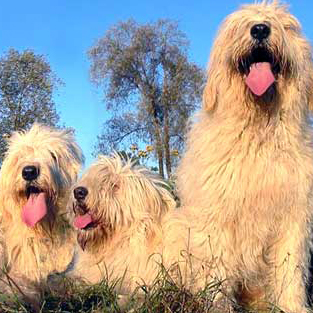
Characteristics
Learn About the South Russian Ovcharka
Description
General Description
The South Russian Ovtcharka is robust and lean with massive bone structure and strongly developed musculature. The coat is coarse, thick and dense, and of equal length on the head, chest, legs and tail, with a well-developed undercoat. Coat colors are most often white but also white and yellow, straw color, grayish (ashen gray) and other shades of gray, white lightly marked with gray and gray speckled. The head is an elongated shape with a moderately broad forehead; the occipital crest and the zeugmatic arches are strongly pronounced. The stop is barely visible. The nose is big and black. The ears are relatively small, of triangular shape and hanging. The eyes are oval shape, set horizontally, dark; the eyelids are lean and tight. The teeth are white, big, fitting closely. The incisors are set regularly and close in scissor bite. The neck is lean, muscular, of moderate length, set high. The chest is reasonably broad, slightly flattened and deep. The belly is moderately tucked up. The loin is short, broad and rounded. The withers are apparent but not high. Back is straight and strong. The tail falls at rest, reaching the hock, with the end curved upward. The front legs are straight, parallel and relatively long. The angle formed by the shoulder bone and upper arm bone is about 100 degrees. Pasterns are strong, wide and long, with a slight slant. Hindquarters are powerful, wide set, parallel and well-angulated. The upper thighs are well-muscled. Stifle bones are long and inclined. Hock joint is clean-cut and angular. The hock is strong, long and slightly inclined. The feet are oval shaped, strong, well-arched and covered with long hair.
Size
On average, these dogs measure between 65 to 66 cm (25 to 26 inches) tall and weighs 108 to 110 kg (48 to 50 pounds) for males, while these dogs measure between 62 to 66 cm (24 to 26 inches) tall and weighs 110 kg (48 to 50 pounds) for females.
Coat
The coat on South Russian Ovtcharka is coarse, thick and dense, and of equal length on the head, chest, legs and tail, with a well-developed undercoat. Coat colors are most often white but also white and yellow, straw color, grayish (ashen gray) and other shades of gray, white lightly marked with gray and gray speckled.
Short History of the South Russian Ovcharka
Historians have different versions about the SRO breed’s origin. Some believe the SRO is developed from Pra-slavics (arias dogs). They resided at the SROs place of origin at 4 BC and used the original pre-historic bearded (“broudasti” in Russian) dogs as herders and guardians. They were described by L.P Sabaneev as Russian Shepherds or Russian wolf-killers. As the arias moved west and north, and those tribes were named Slavic, the bearded dogs were referred to as Russian Shepherds. Dogs were kept in quantity by Russian aristocracy. This is a Russian Native Breed, completely developed by 1790.
In another version, the SRO originated from European herding dogs of the same hair type known as the Austrian Shepherd. The SRO and European herding dogs of the similar hair type look alike and have the same ancestors. Several herding dogs with long, wooly hair were imported to Russia from Europe. In Russian Imperial Law Books (XXVI volume, 1830) there is mentioned a special breed of dogs imported at 1797 from Spain with merino sheep. Those dogs were used for both herding and protection against predators, highly praised for their abilities. Law books recommended breeding these dogs. Russian scientists specializing at southern steppes before 1797 wrote that local sheep herds are protected by wolf-looking dogs and hounds (believed to be SRO ancestors).
Arguments about SRO ancestry are endless. However, there are facts nobody can argue with. SROs definitely have wolf as the direct ancestor. The SRO skull is built almost identical to the wolf’s, with only slight differences, that could be explained by domestication.
Temperament
The Ovtcharka of southern Russia adapts easily to diverse climatic conditions and temperatures. This breed needs an owner who knows how to display strong leadership; someone who is firm, confident, and consistent. You should show your authority over this flock guard, because if you don’t, he may become very dominant with strange people and other dogs. This breed is not very demanding, but he does need a strong-minded human to be his leader. Males are stronger and more massive than females. They were bred to guard their property; therefore, they are independent and will respond negatively to nervous activity. These dogs are strong, balanced and lively. They have a dominant reaction; it is their active way of defense. As guardians they extend themselves to include their families, their home and as much land as they can scent and thus fully call their own. The possessive nature of this dog requires extensive property, a sizable family, and preferably other animals that he can protect. He has a dominating personality and can enforce his will upon other dogs with ease. Socialize well while young. This is not a breed for the inexperienced or meek owner.
Caring for Your South Russian Ovcharka
General Health
The South Russian Ovtcharka has no health issues so far.
Care
Daily
Frequent brushing will help reduce shedding and keep your South Russian Ovcharka clean. Inspect for ticks and fleas daily during the summer or other warm weather. Most south russian ovcharkas don’t need to be bathed more than a few times per year. Prior to a bath, comb or cut out all mats from the south russian ovcharka’s coat. Rinse all soap from the coat, or dirt will stick to soap residue.
.
Grooming & Bathing
Frequent brushing will help reduce shedding and keep your south russian ovcharka clean. Inspect for ticks and fleas daily during the summer or other warm weather. Most south russian ovcharkas don’t need to be bathed more than a few times per year. Prior to a bath, comb or cut out all mats from the south russian ovcharka’s coat. Rinse all soap from the coat, or dirt will stick to soap residue.
Exercise & Training
South Russian Ovcharkas must get some daily exercise to stay in shape, recharge their minds, and keep healthy. Daily activity also tends to help South Russian Ovcharkas avoid boredom, which has the potential to lead to naughty behavior. Playing outside will cure many of your South Russian Ovcharka’s instinctual urges to dig, retrieve, chase, chew and herd. Exercise needs can depend on your South Russian Ovcharka’s level of health and his age—but 10 minutes in back of the house and merely a walk down the street every day probably won’t cut it.

